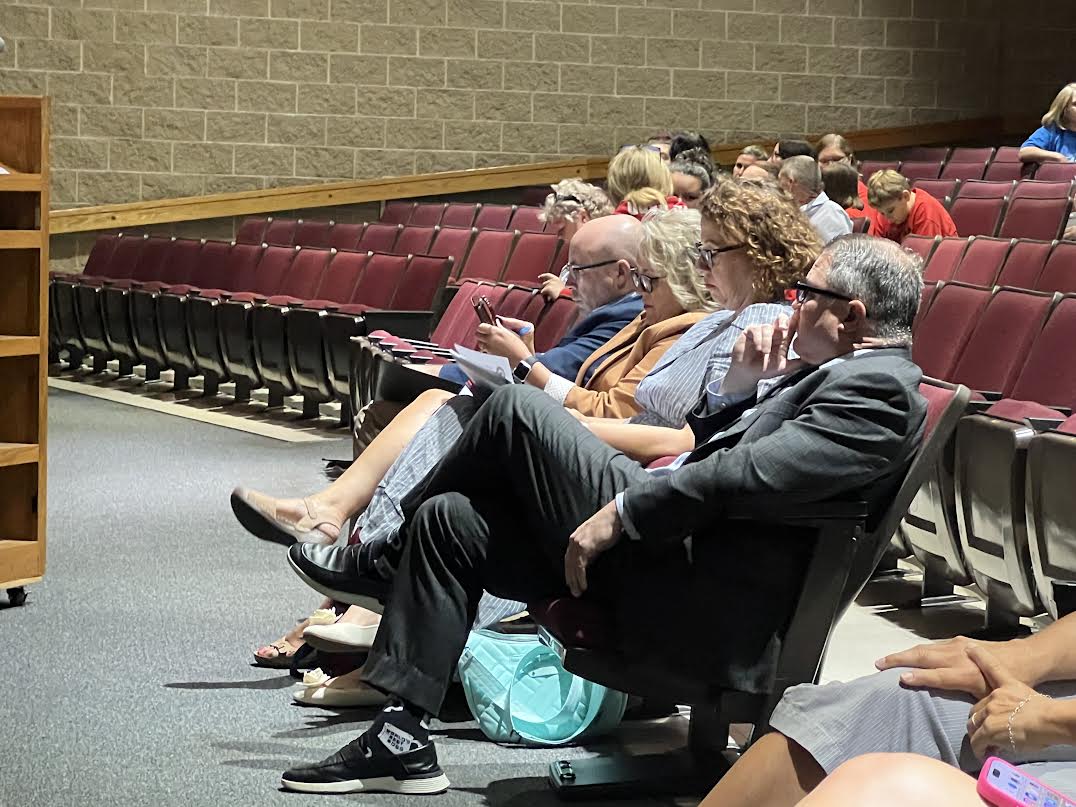Visit From the State
Officials provide State of Emergency information for Randolph BOE

The Inter-Mountain photo by Edgar Kelley Alexandra Criner, Micah Whitlow and Uriah Cummings from the state Department of Education spoke at the Randolph County Board of Education meeting Tuesday night at Elkins High School.
ELKINS — Three representatives from the West Virginia Department of Education visited the Elkins High School Auditorium Tuesday night to speak during a Randolph County Board of Education meeting.
Alexandra Criner, director of the Office of Accountability with the state Department of Education, explained what a State of Emergency means for Randolph County Schools, which was placed in a State of Emergency in June and will remain there for a total of six months.
“A State of Emergency is basically a probationary period where extraordinary circumstances have been identified in a school district, but they don’t rise to the level of an immediate intervention or takeover,” Criner said Tuesday night. “So extraordinary circumstances can be misappropriation of funds, misuse of public funds, falsification of reports, failure to submit the required reports, or a violation of West Virginia code or policy that impacts the provision of an appropriate educational program.”
Criner said that during the sixth-month probationary period, the state Department of Education will provide an action plan to the state BOE.
“The state board will approve the action plan as appropriate and we will work with Dr. Dilly and the folks here to implement the recommendations that we make,” Criner said.
Criner said the state’s goals and expectations for the action plan given to Randolph County Schools include:
* Training and support for board members and the Superintendent of Schools Dr. Shawn Dilly regarding board member roles and responsibilities, including their authority as board members to direct the Superintendent to provide additional information regarding critical issues such as personnel and school consolidation;
* Working with an assigned mentor for the superintendent and Central Office staff to create a leadership team to assist and develop a collaborative working environment that keeps the board informed and engaged;
* Ensuring a school consolidation plan and proposal for a balanced budget has been approved before the December state Board of Education meeting.
“At the end of the sixth-month period, which at this point will be at the December WVBE meeting, the progress that is made toward those goals will be presented,” Criner said. “At that point and time, the state board will decide whether or not enough progress has been made to release Randolph County from the state of emergency.
“They can extend the state of emergency for an additional six months, or they can vote that not enough progress has been made, and they can vote to immediately intervene in the operation of the school system.”
Criner said progress has been documented and that her department is working with Dilly on a plan.
“We have an action plan that is housed in a planner and both of us can use those shared files in order to update progress and communicate about those files,” Criner said. “So we are monitoring that and working toward those goals with (Dilly).”
Micah Whitlow, Schools Facilities director for the state Department of Education, spoke Tuesday night about decision-making and the utilization of schools.
“It’s really a relationship between the personal enrollment of the school and the educational capacity,” Whitlow said. “Say a classroom can hold 24 students because that’s the ability of the teacher, to teach 25. So you count those rooms and that figures out the capacity of the school and you do that math to get your utilization.”
Whitlow said he went back and checked on how Randolph County has trended in school utilization over the past 15 years, noting the average utilization was 74.9%. He said the average for the past five years is down to 62.5%.
“Just using the enrollment from the 2024-25 year, your (RCS) utilization was about 55%,” Whitlow said. “That’s generally on par with the state average, but it’s important to point out that the drop is kind of a noticeable trend that you have to account for as you’re managing your facilities, knowing that trend and drop in enrollment and extra capacity in schools affects a lot of things.”
Whitlow said the average age of the schools in Randolph County is 58 years, and outside of Elkins High School, most of the buildings were constructed in the 1960s and 1970s.
“Usually when buildings are that old, the maintenance issues compound,” Whitlow said. “There’s really not a lot of maintenance for years after a school is first built and your money can go elsewhere in the county… With the whole county being at that age, it could create a problem where you are going to run into all the bills coming due at once, basically.”
Whitlow added that the numbers also reflect that staff in the schools are probably underutilized.
“It represents a lot of low class sizes in some areas,” said Whitlow. “So that’s important as you’re planning and making decisions. It’s kind of a thermometer of how things are going.”
Uriah Cummings, School Financial Operations officer for the state Department of Education, pointed out some specific data points.
“Everything I am going to speak to is based on facts,” Cummings said. “At the end of the day, the facts we have in front of us are ultimately the decisions the superintendent, his staff and the board have to base their decisions on.”
Cummings said Randolph County Schools was on the state’s financial watch list back in 2017, but was able to work its way off the list by 2019. He said the school system was put on the list because it was unable to maintain a certain percentage in its General Fund that is required by the state.
“Then we hit COVID and the COVID funds that came with it were utilized by Randolph County Schools as many other counties did in the state,” Cummings said. “They used the funds to their advantage to be able to support the general fund, if you will, to be able to support the employees or compensate the employees at certain levels as they did prior to COVID. So if we look at enrollment trends of the past five years, Randolph County has lost somewhere in the neighborhood of 400 students and it kept a flatline of personnel during that time, again using those funds.”
Cummings said no ESSER (Elementary and Secondary School Emergency Relief) funds, which were supporting 33 profession positions, are available to Randolph County Schools for the Fiscal Year 2025.
He said that, as of Fiscal Year 2025, Randolph County Schools was employing approximately 27 positions over formula out of the general fund, and almost 16 positions of service personnel over formula.
“That equated to approximately $2.8 million that was having to be funded out of the discretionary funds of the district that were not available through the state aid funding formula in which you have to operate,” Cummings said. “In most county situations, we have 42 counties in the state that have an excess levy. So you don’t have to operate a formula, but you do have to have a dedicated funding source to justify going over the formula. Counties that are fortunate to have an excess levy in place are able to support those positions over formula.”
“For fiscal year 2025-26 the county is trending toward spending $5 million out of the discretionary fund balance,” Cummings said.
Cummings noted Randolph County Schools has the highest differential in the state when it comes to per pupil expenditure.
“For Fiscal Year ’24, the county spent approximately $30,000 per pupil for the operation of Pickens Elementary High School, while spending $11,658 per pupil at Elkins High School,” Cummings said. “That is a difference of about $18,430, which is about a 257.49% difference.”
Randolph County Board of Education President Rachel Anger asked Cummings, “Is there any low-hanging fruit that we can go after that is not just consolidating schools?”
Cummings replied, “Honestly, we have been through the budget and there does not appear to be a low-hanging fruit, if you will, that can be cut.”
The next regular Randolph BOE meeting will be Sept. 19 at the Central Office.


